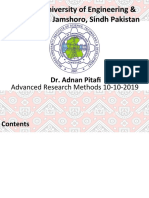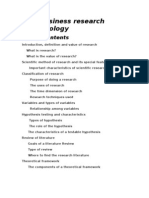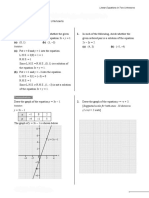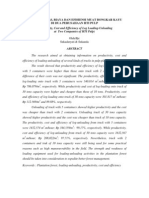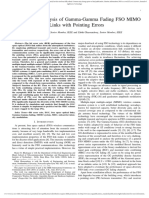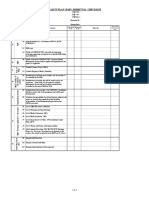Structure of The Thesis Project Development
Uploaded by
ScribdTranslationsStructure of The Thesis Project Development
Uploaded by
ScribdTranslationsSTRUCTURE OF THE THESIS PROJECT
The outline for the preparation and presentation of the research project,
aims to guide the participant in the design of a project, facilitating the
subsequent execution and monitoring tasks, in case it is approved.
I. STATEMENT OF THE PROBLEM
1.1 Problematic Situation
The research problem, according to its scope and nature, must be
explicitly linked (in explanatory or correlational terms) with
the aspects with which it is linked. The criteria are: Importance,
novelty, interest, and viability.
1.2 Statement of the Problem
Answer the question. What does the named problem consist of? The
the problem can be formulated in the form of a question both for the
general problem as for specific problems.
Additionally, it must be indicated whether the entire problem will be developed.
in the investigation or specify the part of it that needs to be addressed
scientifically and that gives the title to the research.
1.3
It is necessary to specify why it is beneficial to study this problem both theoretically
how to practice; and for whom or for whom this study is suitable. The
who or who are institutions, companies or population sectors.
1.4 Research Objectives
1.4.1 General Objective
Answering the question: Why is Research conducted? It is
global purpose of the research.
1.4.2 Specific Objectives
Results from breaking down the general objective and specifying the activities to
execute to achieve the specific goals to obtain.
II. THEORETICAL FRAMEWORK
2.1 Background of the Problem
They are research works that have addressed the same situation.
issues. The bibliographic data of the work must be indicated, the
general objective or problem, the data collection instruments
used and the general conclusion.
2.2 Theoretical Bases Theories or theoretical approaches directly
related to the topic being investigated.
2.3 Conceptual Frameworks or Glossary of Terms. Those that
will be used in the research and need to be specified in the development of
work.
III. HYPOTHESIS AND VARIABLES
3.1 General hypothesis: It is a tentative proposition to make of the possible
relationships between two or more variables.
3.2 Specific hypotheses: These hypotheses are derived from the hypothesis.
general
3.3 Identification of variables: Variables are characteristics,
attributes or properties of a person, an object, or a situation that
they can change (acquire various values), and whose variation is
susceptible to being measured. The variables can be independent,
dependent, qualitative, intervening, etc.
3.4 Operationalization of variables: They are specifications of
activities or operations necessary to measure a variable.
3.5 Consistency matrix: It must have the following columns, for
los aspectos generales: problema general, objetivo general e hipótesis
general, for the case of specific aspects: specific problems,
specific objectives
specific and technical data collection methods for each of the
variables.
IV. METHODOLOGY
4.1 Type and Design of Research
This section explains the type of research to be conducted, that is,
experimental or non-experimental and it is specified how they will be organized
units of analysis for their observation. This is what is known in
experimentation as design and is generally translated into a
graphic representation scheme of how they will relate
variables.
4.2 Unit of analysis
They are the subjects or objects of study (people, organizations, etc.)
4.3 Study Population
The population or universe refers to the set (people, institutions or
things), for which the conclusions obtained will be valid.
4.4 Sample size
From the population it is advisable, for practical reasons, to extract samples or
representative parts.
4.5 Sample selection
Description of the procedure used for sample selection
4.6. Data Collection Techniques
It explains here the procedure, place, and conditions of the collection.
data. It includes here: a) Whether the research will be based on readings,
interviews, surveys, document analysis or direct observation of
the facts; b) the steps that will be taken; and possibly; c) the
instructions for whoever will collect the data.
4.7. Analysis and interpretation of information
This operation describes; a) the process of classification, recording and
data coding; b) analytical techniques (logical or statistical)
which will be used to test the hypothesis and draw conclusions.
V. BUDGET
Distributed by categories: Salaries, Goods, and Services. Here it is evaluated whether
The project is feasible to carry out or not.
VI. SCHEDULE OF ACTIVITIES
Which can be expressed through a graphic schedule that represents in
one of its dimensions the different activities and in the other the times of
corresponding execution.
VII. BIBLIOGRAPHIC REFERENCES
In alphabetical order of the main author. Includes: Books, Scientific Journals,
Editions of Institutions, Theses, Databases via the Internet.
VIII. ANNEXES
Allows you to complete the information developed in the research. The annexes.
they contain tables, maps, diagrams, organizational charts among others.














